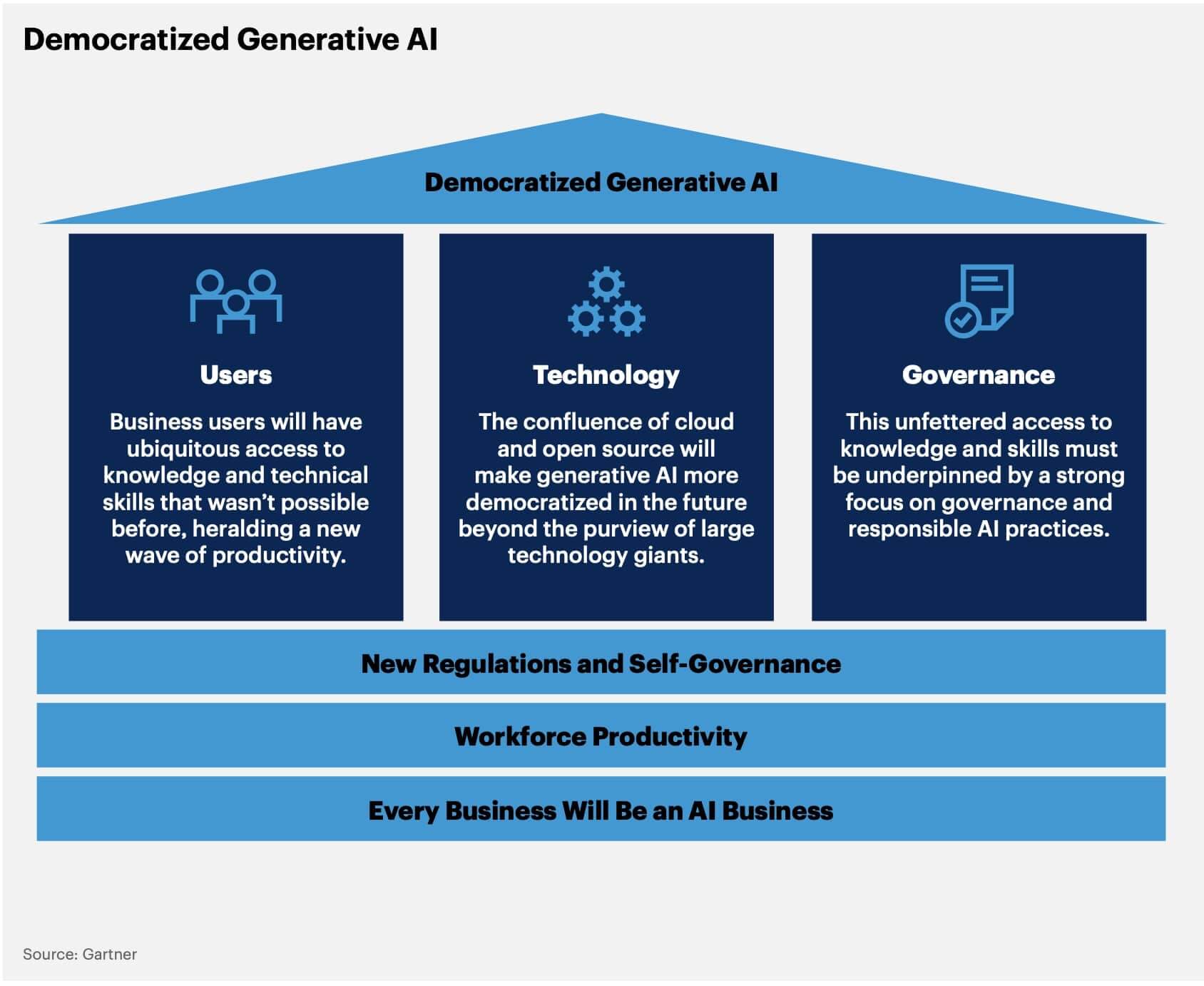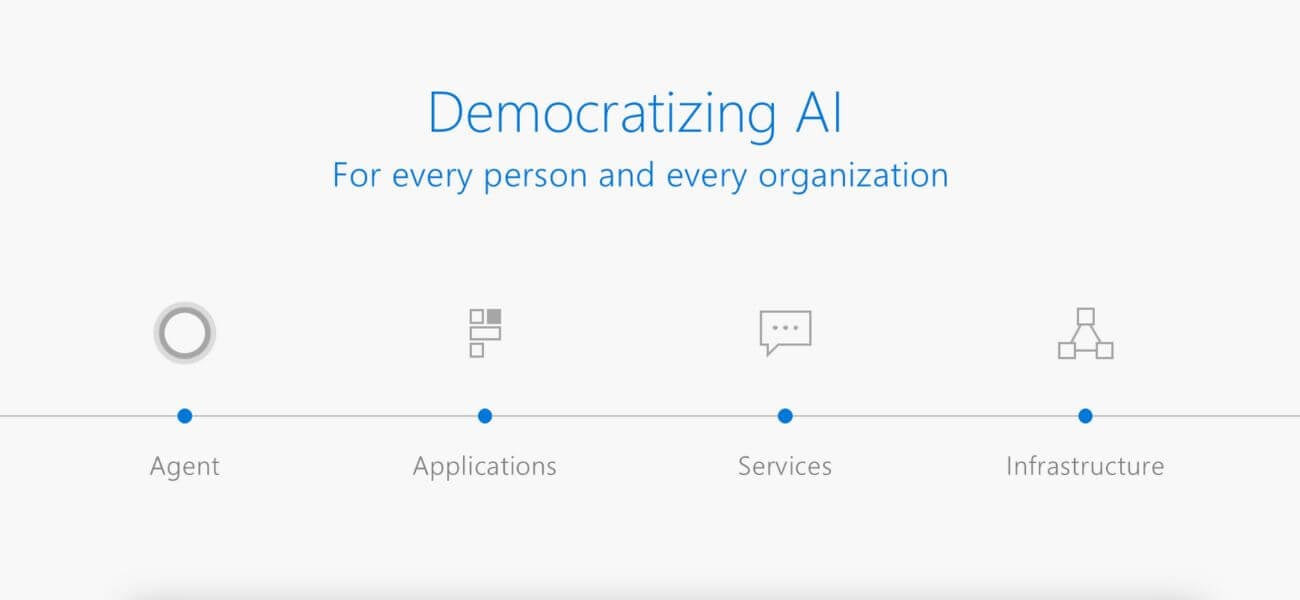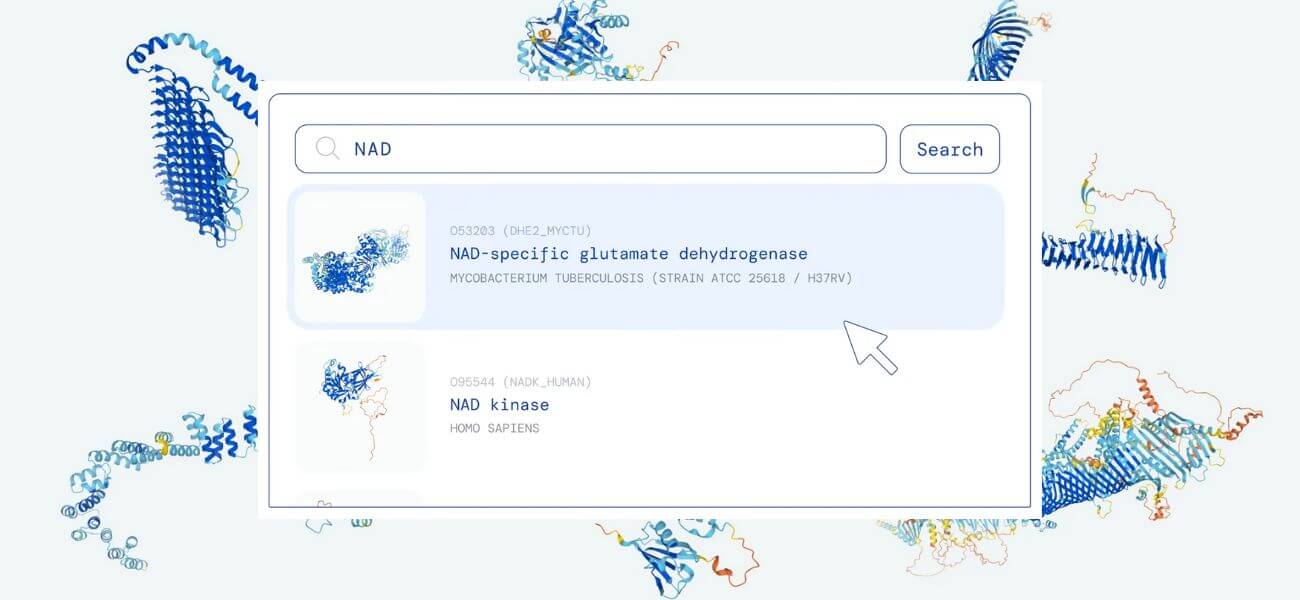Key Takeaways
- AI democratization's multiple meanings highlight its complexity, from access and development to governance and profits, underscoring the need for a nuanced approach.
- The democratization of AI presents both significant opportunities, such as enhancing business efficiency, and challenges, including data privacy concerns.
- To democratize AI, businesses are turning to open-source models and GenAI applications, which allow for greater customization and productivity.
- Ensuring the responsible governance and security of democratizing AI is critical, involving both IT and information security leaders to safeguard against risks.
- Investments in AI tools and training are essential for businesses aiming to fully realize the benefits of democratizing AI, by equipping their workforce with valuable digital skills.
What is Democratize Generative AI?
Democratizing AI means making generative AI technology accessible to everyone. This allows people with different knowledge and skill backgrounds to benefit from the advantages of AI, promoting innovation and creativity across various sectors.
In this blog post, we will discuss that the situation is not exactly as described and that there are multiple meanings behind this concept. But first, let's look at how Gartner defines this concept. Gartner mentioned this concept in its 2024 trend report and indicated that we would hear much more about this concept next year.
The ability to create net new content (images, speech, text and more) and its widespread availability will democratize access to information and skills, making it one of the most disruptive trends of this decade.
Source: Garter

Multiple Meanings of AI Democratization
So far, we have only defined the term "Democratization of AI Use". But is this the only concept that comes to mind when we talk about AI democratization?
According to research and an article by PhD Elizabeth Seger, a researcher at the Artificial Intelligence Governance Centre (GovAI) in Oxford, United Kingdom, four types of "AI democratization" are identified:
1. Democratization of AI Use
The "Democratization of AI Use" highlights the goal of enabling a wide user base to easily use AI technology and to extend the benefits of artificial intelligence for the advantage of more people.
Positive Impacts:
- Makes technology access easier for a wide audience
- Distributes the benefits of using artificial intelligence to a broad audience
- Provides financial gains for those integrating AI tools into workflows
The democratization of AI use expands access to technology and offers the benefits of artificial intelligence to a wider audience, ensuring that technological advancement is not limited to a specific group. This approach enables financial gains through the smart integration of AI tools into operational processes.
We can explain these impacts with an example. Microsoft is moving forward with four main strategies to make AI technology more accessible and useful for everyone:
- Reshaping the computing around us and our interaction tools
- Adding intelligence to every kind of application
- Making produced smart capabilities (cognitive abilities) available to every application developer in the world
- Opening powerful AI supercomputers to everyone's use
Microsoft collaborates with big names like Ecolab, Schneider Electric, and Rolls-Royce, offering artificial intelligence in various fields such as healthcare, personalized medicine, and agriculture. With this approach, artificial intelligence is used to create a wider impact and improve the world. For more information, you can check out Microsoft's article on democratizing AI: Democratizing AI - Stories.

Challenges:
- The risks of human-AI interaction without extensive training or technical knowledge.
Democratizing the use of AI tools carries risks due to a lack of education and technical knowledge. This can lead to misunderstandings and unexpected outcomes, so caution is needed in this process.
2. Democratization of AI Development
We can think of the Democratization of AI Development as opening the doors wide for everyone to add their touch to the future of technology.
Imagine this as expanding the AI playground and inviting everyone to play. The key is to use this technology to break down barriers to access for everyone, allowing ideas to flourish from every corner of the world.
Positive Impacts:
- More people contributing leads to an increase in innovative ideas.
- Benefiting from a worldwide developer community accelerates innovation.
- Developing AI solutions for diverse needs becomes easier.
Challenges:
- The risk of misuse increases.
- Controlling innovation becomes more difficult.
AI systems are becoming a part of everyday life. The key is to ensure that these machines are aligned with human intentions and values.
Mira Murati - Chief Technology Officer at OpenAI
In keeping with the spirit of sharing and development, platforms like OpenAI take on this responsibility and aim for the future of artificial intelligence to be not only smart but also safe and robust. To learn more about how they achieve this, you can read OpenAI's article, "Developing Safe & Responsible AI."
3. Democratization of AI Profits
The democratization of AI profits is a concept focused on the fair distribution of the benefits and profits generated by artificial intelligence. The goal is to prevent the concentration of AI profits in the hands of a few organizations or individuals, thereby promoting a more inclusive and fair AI ecosystem.
Imagine a collaborative AI development project. In such a setup, numerous participants, from data scientists and engineers to end users providing feedback, work together to develop an AI system. Instead of profits accumulating in a single organization, they are shared among all contributors. This approach not only encourages participation but also ensures a more equitable distribution of the wealth generated by artificial intelligence.
Positive Impacts:
- Narrowing of the socioeconomic gap.
- Easing the financial burden of job losses due to automation.
- Facilitating economic transition in case of rapid growth in the AI industry.
Challenges:
- Laboratories and organizations not being fast and effective enough in developing AI for the public good.
Some organizations try to extend the positive impacts of advanced AI technologies by offering their research and development for the public benefit. This can provide economic benefits as well as enhance the overall impact of AI applications.
A great example of this is DeepMind's work on AlphaFold. This project made significant progress in the field of protein folding, accelerating medical research and having the potential to develop new treatments for diseases, demonstrating the benefits of democratizing AI in the healthcare sector. For more information, you can look into DeepMind's publications on the AlphaFold system.

4. Democratization of AI Governance
Another definition is the Democratization of AI Governance. This concept is about ensuring that decisions related to the use, development, and distribution of artificial intelligence reflect the preferences and interests of the affected communities.
Positive Impacts:
- Balancing risks and benefits.
- Reflecting people's interests and preferences.
- Shifting control from big tech companies to a broader audience.
- Fair distribution of benefits and burdens.
Challenges:
- The complexity of implementing this process.
- Conflicts of interest.
OpenAI integrates community suggestions and grant programs to promote democratic participation in the selection and funding processes of AI projects, aiming to make decisions in the field of AI more democratic. This plays a critical role in guiding AI development by directly receiving feedback and suggestions from diverse communities. For details, you can refer to OpenAI's blog post: Democratic Inputs to AI Grant Program Update.
The four types of AI democratization sometimes complement each other. For example, the public's desire to restrict access to AI systems might necessitate a balance between democratizing governance and democratizing development. This underscores the multifaceted nature and significance of AI democratization.
In light of all this information, understanding the democratization of AI rests on two critical points:
- Democratization does not mean the same as widespread dissemination of the model.
- The value of democratization is measured by how well it responds to the interests and values of the affected communities.
This inference actually shows us that understanding the concept of democratized AI with just a single definition can be difficult. By approaching this concept from different angles, we can say how important a balanced approach in the management of artificial intelligence technologies is and the necessity of taking into account the needs and values of various communities. The risks of misuse or uninformed approaches should also be discussed separately.
Featured Source:
Fake News 3.0: The Era of Automated Fake Information
Democratization of AI Creates Benefits and Challenges
Artificial Intelligence (AI) technologies becoming accessible to everyone are at the forefront of technological transformation in today’s world. This process offers wider audiences opportunities for innovation and creativity, enhances efficiency in business processes, and makes advanced technologies more accessible. However, alongside these positive developments, it also brings significant barriers such as data security, ethical issues, and regulatory challenges.
Here is a picture of the widespread adoption of AI, considering both its advantages and challenges:
Benefits
- Supporting Creativity and Innovation: Artificial intelligence inspires a broad range of users to develop innovative solutions across different sectors.
- Increase in Efficiency in Business Processes: Automation allows people to allocate their time to more creative and strategic tasks, significantly boosting overall productivity.
- General Access to Advanced Technologies: Ensures that everyone from small businesses to large corporations can benefit from the latest AI tools, thereby promoting technological equity.
- Personalization of Individual Experiences: Products and services can be personalized according to user preferences and needs, making them more personal and effective.
- Multi-Domain Innovation: AI opens the door to interdisciplinary innovations by offering solutions in many fields from health to education, agriculture to finance.
Challenges
- Data Privacy and Security Risks: The widespread use of AI brings increased risks for personal data protection and security breaches.
- Misinformation and Ethical Concerns: Automated content generation could lead to the spread of misleading information and challenge ethical boundaries.
- Skills Deterioration and Dependency: Overreliance on AI may diminish people's analytical thinking and problem-solving abilities.
- Regulation and Governance Complexity: The rapid development of AI technologies can make it difficult to establish effective and fair regulations.
- Transparency in Decision-Making Processes: AI decision-making processes can sometimes be opaque, making it challenging to understand how they work and assess their reliability.
- Copyright and Misuse Issues: AI's capacity to create creative works can lead to complex issues involving copyright violations and unethical use.
- Unintended Consequences: The widespread implementation of AI could have unpredictable effects on society and the economy.
The proliferation of AI presents both significant opportunities and challenges. To best harness the potential of this technology and overcome the obstacles faced, a balanced approach and a firm commitment to ethical standards are necessary. Diligent efforts in areas such as data privacy, security, and ethical use will ensure AI remains a positive force for society.
Additionally, considering the rapid development of technology, the creation of flexible and inclusive regulations is of great importance. The future of AI technology will depend on how these challenges are addressed and how the technology is directed for the benefit of humanity.
How the Democratization of AI Impacts Enterprise-IT
The democratization of artificial intelligence is creating significant impacts on business IT infrastructures. Especially, open-source models are offering organizations new and flexible deployment options. Through these models, companies can have more control over security and privacy issues.
Moreover, the ability to shape and customize these models according to their needs provides a great advantage to businesses. In other words, open-source AI models help companies develop more efficient and effective solutions by allowing them to adapt the technology to their specific situations.
The emergence of generative AI (GenAI) applications is bringing about a significant acceleration and increase in efficiency in business processes. For instance, time-consuming and repetitive tasks such as email writing, code generation, or summarizing extensive documents can be completed much faster with these applications. This situation allows employees to allocate their time to higher-value tasks.
Furthermore, through personalized AI assistants, employees can become experts in new tasks more quickly. In other words, GenAI applications enable businesses to lighten their current workload and expand their employees' skills. These developments are opening a new chapter in how business IT infrastructures are managed and developed.
IT Is Ultimately Responsible for GenAI Security
According to a survey conducted by Gartner between April 1-7, 2023, 93% of IT and information security leaders stated that they were at least somewhat involved in their organization's generative AI (GenAI) security and risk management efforts. However, only 24% said they fully took on this responsibility. Among those who did not assume full responsibility, 44% mentioned that the ultimate responsibility for GenAI security lies within IT, while 20% indicated that it belonged to their organization's governance, risk, and compliance departments.
From this data, we conclude that significant tasks fall to IT leaders. Primarily, they should create a priority matrix for GenAI use cases and set a timeline to adapt these scenarios through pilot application, deployment, and production processes. Additionally, while automating routine tasks, they must adopt a change management strategy that prioritizes training and well-being to ensure employees can use GenAI tools safely.
The responsible proliferation of GenAI, informing managers, and ensuring the accuracy, originality, and security of content to prevent potential unintended consequences are of critical importance. These approaches help organizations integrate GenAI technologies efficiently and safely while minimizing potential risks. Therefore, IT and information security leaders must carefully plan and implement strategies for security and risk management while leveraging the opportunities GenAI offers.
Conclusion
Professionals need to understand the power of artificial intelligence, develop the right use cases, and apply findings to achieve business outcomes and insights. Therefore, leaders should make smart investments in AI tools and training for their employees.
Businesses should adequately educate their employees on what artificial intelligence is and how AI can be applied to daily tasks effectively. The democratization of AI reduces barriers to AI usage, lowers expenses, and supports the development of high-accuracy AI models.
The democratization of AI enables businesses to provide their employees with valuable digital skills, which can boost worker productivity. This approach can help companies narrow the IT skills gap and save on costs as well.
Implementing new systems and capabilities without proper guidance can pose significant risks. Inadequate training and application can lead to managers making decisions based on incorrect data or biases. Therefore, managers must fully understand who will be using AI modeling and development tools to create safe and responsible AI standards.
To minimize risks, training plans for enhancing employee skills and facilitating re-skilling should be developed.






(4).jpg)


